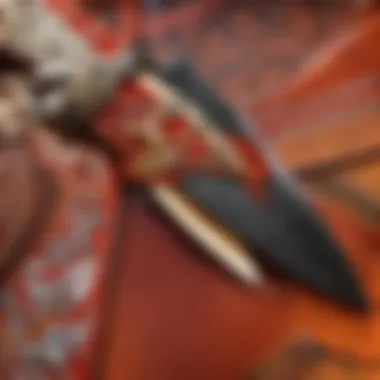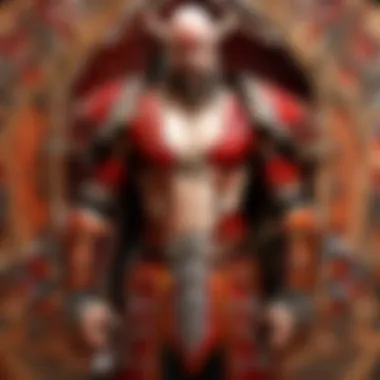Harnessing Exotic Leather Scraps for Sustainable Innovation


Intro
In recent years, the discussion surrounding sustainability has reached critical importance across various sectors. One subject that has emerged is the innovative use of exotic leather scraps. As industries and consumers seek more responsible sourcing methods, exploring how these leather remnants are applied can shed light on both environmental and creative implications.
Signifiance of Exotic Leather Scraps
Exotic leather scraps refer to waste materials derived from animals such as alligators, snakes, and ostriches. These byproducts often end up discarded, contributing to environmental waste. However, as awareness grows, there’s a movement toward reimagining these scraps for artistic and functional use.
The blending of sustainability in fashion, art, and design not only reduces waste but also opens new avenues for craftsmanship. The importance of addressing how we manage these products underlies the broader themes of ethical consumption and innovative creativity.
Sourcing Methods
Sourcing methods for exotic leather are essential for understanding the implications of their use. The primary concern should always be ethical sourcing. Sustainable alternatives focus on rigorous regulations related to wildlife protection and fair labor. By choosing suppliers committed to environmental stewardship, brands ensure their practices do not harm ecosystems.
Responsible Supply Chains
Using transparent supply chains reduces risks of exploiting endangered species. For example, several brands are now highlighting their partnerships with local artisans who are dedicated to sustainable practices. Such collaboration can bring economic benefits to local communities while preserving traditional craftsmanship skills. Sustainable development becomes a real possibility when businesses commit to responsible sourcing.
Sustainable Practices
Sustainability involves more than just sourcing. Transforming exotic leather scraps into usable products requires innovative techniques that prioritize minimal waste and environmental impact. Here are some notable methods adopted in this context:
- Upcycling: This practice involves creating new products from waste materials. Designers are turning scraps into accessories, clothing, and home decor items.
- Eco-Friendly Processing: Rather than traditional tanning methods that often involve harmful chemicals, alternatives are being implemented. For instance, vegetable tanning utilizes natural materials and is significantly less polluting.
Implementing these practices not only enhances the reputation of brands but also resonates with customers who value sustainable purchasing options.
Innovative Applications
The applications of exotic leather scraps span across various realms of creativity. In the fashion industry, waste materials are often turned into unique pieces that stand out in the marketplace.
Fashion Innovations
Emerging designers are using exotic leather remnants for custom and high-end apparel. Items like handbags, wallets, and shoes are not only functional but carry an essence of art. In some cases, one-of-a-kind pieces foster a sense of exclusivity, appealing to environmentally-conscious consumers seeking authentic products.
Art and Design
In the world of art, creators are experimenting with these materials to produce striking sculptures and installations. The texture and patterns derived from exotic leather enhance artistic depth. Consequently, projects combine aesthetic appeal with commentary on consumption, waste, and sustainability.
The transformation of exotic leather scraps is more than just a trend; it symbolizes a shift in perception about waste in our society.
Economic Considerations
Exploring exotic leather scraps also opens dialogues around economic considerations. By leveraging waste materials, brands can decrease production costs while minimizing environmental footprints. This balance can create a compelling business model that attracts environmentally-minded investors.
Economic Benefits
Utilizing scraps contributes directly to economic sustainability. More investment in sustainable practices may increase job opportunities within communities involved in the processing and crafting stages.
Craftsmanship and Skills
An often-overlooked aspect of using exotic leather scraps is the impact on craftsmanship. By focusing on creating products from these materials, there’s a revival of traditional skills along with the development of new techniques.
Preserving Heritage Crafts
As artisans embrace modern designs, they blend traditional know-how with contemporary innovation. This merging preserves age-old techniques while fostering creativity in product creation.
Prelude to Exotic Leather Scraps
Exotic leather scraps hold a notable position within the conversation surrounding sustainability and innovation in various industries. As we grow increasingly aware of environmental concerns, the discourse around these scraps emphasizes not only recycling but also creative application. This material is noteworthy because it reflects a commitment to reducing waste and finding novel uses for byproducts that would otherwise be discarded.
Defining Exotic Leathers


Exotic leathers are derived from the hides of non-traditional animals, which may include species such as crocodiles, alligators, snakes, and lizards. These materials are often sought after for their distinctive textures and aesthetics. Collections may range extensively in style, quality, and price. Their unique appeal makes them highly valued in high-end fashion and luxury goods sectors, giving rise to a market that thrives on exclusivity. However, understanding exotic leathers involves recognizing not just their allure but also the ethical implications and environmental considerations surrounding sourcing.
Sourcing Exotic Leather Scraps
The sourcing of exotic leather scraps emerges as a critical theme in the discussions of sustainability and innovation. By understanding where and how these materials are obtained, stakeholders can enhance their practices including ethical considerations, and contribute to a responsible economic model. The spotlight on sourcing elevates awareness about the potential risks involved. Safeguarding natural habitats while ferreting out value from byproducts becomes increasingly significant. Furthermore, sourcing practices can shape brand reputations. Consumers more often choose brands that prioritize sustainability. It’s about blending luxurious materials with conscientious practices.
Global Market Trends
Global market trends indicate a robust expansion for exotic leather products. Though there is a tactile excitement surrounding exotic leather pieces, awareness of sustainability bears hefty financial implications. The trend of using these scraps plays a structural role as businesses search for methods to minimize waste and optimize resources. According to experts, the appetite for luxury items has strong backing from economic growth in emerging markets. With the integration of eco-friendly methods on the rise, many entrenched sectors such as fashion adapt to the sustainable narrative. Reports have surfaced showing a growth trajectory in niche applications of these materials, such as in vibrantly produced fashion items and artistic renditions. This merge highlights the eco-friendly shift wired into today’s marketplace.
Ethical Sourcing Practices
Exploring ethical sourcing practices sheds light on the essential behaviors required in responsible exotic leather acquisition. Implementing these practices fulfills social responsibilities while establishing trust. Industries that promote transparent sourcing are appealing to higher-end consumer bases. Overall, creating a positive narrative encourages examination of the entire supply chain. This includes interactions with local communities and compliance rails guiding animal welfare. When looking at renowned manufacturers—brands like Gucci and Hermès are at the forefront. They direct attention to sustainability by reshaping their sources based on units available across the ecosystem. Additionally, compliance with international regulations ensures an added layer of reliability. Progressing towards certifications that prioritise ethical practices not only improves accountability, but also safeguards brand integrity over time.
This emerging focus on ethical sourcing affects the perception not only of businesses but also reshapes consumer trust.
Environmental Impact of Exotic Leather Production
Understanding the environmental impact of exotic leather production is essential for grasping the complexities associated with it. The significance of this topic cannot be understated. It offers insight into the delicate balance between a thriving industry and sustainability. Exotic leather production involves various processes. Each of these steps has a unique environmental footprint. Consequently, analyzing this impact unfolds into a larger narrative about ethics, commerce, and the planet's wellbeing.
There are specific elements worth considering, such as carbon emissions, resource depletion, and ecosystem disturbance. Accepting complexity in these areas provides a clearer picture of production. Amid these challenges, there are also various benefits. They manifest through innovative practices aimed at reducing harm to the environment.
Exotic leather scraps represent an opportunity; they minimize waste and can be repurposed into high-value products that both satisfy consumer demand and prioritize ecological balance.
Carbon Footprint Analysis
The carbon footprint in exotic leather production primarily stems from livestock farming and processing methods. Ruminants, like alligators or ostriches, produce methane—a greenhouse gas far more potent than carbon dioxide. Raising these animals, therefore, contributes disproportionately to carbon emissions. DeForestation for grazing land can exacerbate this issue, leading to greater emissions.
Further down the line, the production phase involves energy-intensive processes. Such processes include tanning and dyeing. These can leave a significant carbon trail and may use harmful materials unless sustainable practices are implemented. The examination of carbon footprints confirms the need for innovative methods reducing energy requirements.
Reduction strategies may involve adopting renewable energy sources or improving techniques to operate under lower emissions standards. Accurately assessing carbon footprint dimensions is a critical stepping stone toward embracing sustainable practices.
Waste Management Strategies
Effective waste management is a crucial area in diminshing the overall environmental impacts of exotic leather production. Unlike traditional leather, there is a need to develop techniques specific to exotic leathers, which possess unique processing requirements.
There are several strategies in waste management:
- Circular Economy Models: Using waste as raw materials in other processes. For instance, incorporating leather scraps in new products can remarkably decrease total waste output.
- Recycling Initiatives: Efforts to reclaim materials that typically would end up in landfills, redistributing them back into the economy through various production cycles.
- Chemical Treatments: Processes to diminish the environmental impact of trimming and material waste while utilizing biodegradable or eco-friendly solutions whenever possible.
Industry leaders recognize these strategies hold the power to transform operations toward reduced ecological footprints. All stakeholders have their roles in educating and promoting awareness about responsible sourcing and recycling of exotic leather scraps.
This approach not only uplifts ethical standards but also improves perceptions surrounding exotic leather.
Ultimately, these waste management strategies link closely to economic viability. Taking initiative on these aspects shows a commitment to sustainability which consumers often favour.
Innovative Applications of Exotic Leather Scraps
The utilization of exotic leather scraps in various fields represents a significant shift in creative and sustainable practices. Knowing potential applications can open doors for innovation across industries, enhancing both material efficiency and design uniqueness. From the fashion industry to artisanal crafts and interior design, exotic leather scraps offer functional and aesthetic advantages.
Fashion Industry Adaptations
High-End Accessories
High-end accessories created from exotic leather scraps have become increasingly prominent. The appeal of luxuriously textured and visually captivating materials resonates with consumers' desire for unique pieces. Brands have started to integrate these scraps into wallets, belts, and handbags, reinforcing a custom aesthetic that adds exclusivity. A critical characteristic of high-end accessories is their craftsmanship, which often steepens the price point but underscores durability and artistry.
One unique feature of these accessories is the individual character inherited from previously discarded leather. Each item can tell a story through its unique imperfections. However, this also poses a challenge; ensuring ethical sourcing without compromising quality remains crucial to maintain consumer trust.
Sustainable Footwear
The use of exotic leather scraps in sustainable footwear has gained considerable traction. This approach not only reduces waste but also embraces the rich textures and colors traditionally associated with luxury footwear. Its primary benefit is a reduced environmental footprint compared to using whole hides, which can be resource-intensive.
Footwear produced from these scraps can boast individual design options that attract eco-conscious consumers. One clear advantage is the ability to create limited-edition collections, appealing to both luxury-seeking individuals and those who value sustainability. The drawback is the potential difficulty in maintaining uniformity in production, as the supplies can vary significantly.


Art and Craft Projects
Unique Art Installations
The emergence of unique art installations using exotic leather scraps showcases the materials' versatility. Artists can create compelling works that engage by using texture and color to draw viewers in. These installations provide an interesting perspective on the intersection of art and environmental consideration, highlighting the value of what is often considered waste.
The intricate designs realistic, since the distinctive marks and textures in the leather catch light uniquely pulling in viewers' attention. One drawback might be the questions of longevity of art installations made with natural materials which can be affected by environment over time.
Handcrafted Works
Handcrafted works leverage debris from exotic leather has become a crucial avenue for individual artisans. Items such as bespoke jewelry, wallets, and home decor are often crafted from these materials, giving each piece, individuality. A defining characteristics of handcrafted designs is the skill and story behind each work attached to consciousness of sustainable creativity.
The unique trait of handcrafted leather products is customization. Consumers often feel stronger connection to customized items. However, higher labor costs associated with handcrafted production can lead to elevated prices for consumers, which can limit their market reach.
Interior Design Innovations
Decorative Elements
Incorporating decorative elements made from exotic leather scraps has emerged as an exciting prospect for interior designers. These elements add sophistication and warmth to decorating schemes. Examples include wall art, lamp shades, and furniture accents. The highly tactile quality of leather provides sensory contrast to other materials in interior environments.
Its strong durability represents an aspect that classic furnishings can often lack. Some challenges include careful consideration of maintenance and cleaning methods, since if improperly cared for it may result in degradation, or application related aesthetic issues.
Custom Furnishings
Custom furnishings fashioned from exotic leather scraps provide unique opportunities for interior spaces. Designers often use these scraps to create bespoke furniture items like sofas or chairs. This important adaptability opens the door for personalized home aesthetics. It's noteworthy that customization can invite ambiance that mass-produced items do not offer.
However, as with decorative elements, the issue of sourcing them ethically can arise. Quality control presents a challenge due to variations inherent to using scraps. Still, the allure of owning a distinct piece often overshadows such characteristic issues.
In examining the creative applications of exotic leather scraps, emphasis on sustainability is seen in every industry. This should motivate higher engagement between material handlers, designers, and consumers making informed choices driven toward their aesthetic sense while respecting our shared environment.
Economic Considerations
Understanding the economic implications of using exotic leather scraps plays a vital role in appreciating their value. The effective management of these materials can create a substantial impact in various industries. By focusing on cost-effectiveness and market opportunities, businesses can explore ways to enhance profitability while adhering to sustainable practices.
Cost-Effectiveness of Using Scraps
Employing exotic leather scraps can lead to notable cost savings for manufacturers and designers. These scraps often come at a lower price compared to full hides, which can significantly reduce production costs. Additionally, opting for scraps means being more efficient in resource usage.
Some benefits of cost-effectiveness include:
- Reduced Material Waste: By utilizing scraps, companies can minimize their environmental footprint.
- Competitive Pricing: Offering products made from scraps can allow brands to position themselves competitively in the market.
- Less Investment in Resources: Using pre-cut leather pieces or offcuts decreases the need for extensive processing.
- Enhanced Profit Margins: Lowering costs increases profit margins, even while maintaining product quality.
The strategy of using exotic leather scraps is not just sensible; it can redefine how companies view budgeting and resource procurement.
Market Opportunities for Designers
In the increasingly eco-conscious market landscape, designers have a unique opportunity to capitalize on trends favoring sustainability. The rise of using exotic leather scraps aligns perfectly with contemporary consumer preferences—a sharp shift towards ethically responsible products.
Designers may discover several avenues for market growth inclding:
- Distinctive Fashion Lines: Scraps provide an opportunity to create unique and exclusive designs.
- Niche Markets: Brands can cater to specific clientele drawn to sustainable luxury and craftsmanship.
- Collaborations: Partnerships with artisans produce premium, handcrafted items, further attracting discerning consumers.
Engaging with the concept of exotic leather scraps paves pathways toward innovative designs while remaining environmentally conscious. As designers embrace these opportunities, they also contribute to reshaping the future of fashion and craftsmanship,
“Utilizing exotic leather scraps not only meets consumer interest but promotes sustainable innovation. The economic benefits are significant.”
Challenges and Controversies
Understanding the challenges and controversies surrounding exotic leather scraps is vital for a complete perspective on their use. The exotic leather industry presents significant ethical and environmental concerns, alongside emerging innovations and practices. These challenges shape the perceptions of the material and guide regulatory decisions that impact market practices.
Perception of Exotic Leather


The perception of exotic leather plays a critical role in its acceptance and usability in various applications. Materials such as python, crocodile, and ostrich are often seen as luxurious, yet controversial due to their origins. Some consumers appreciate the craftsmanship and rarity, while others express concerns about sustainability and animal welfare.
Issues arise from the belief that these materials contribute to animal endangerment and environmental degradation. Public awareness campaigns and documentaries have spotlighted the dark sides of exotic leather production, leading to increasing scrutiny.
The fashion and communities associated with them are at a turning point. Many designers strive to frame the use of exotic leathers in a more positive light, focusing on their innovative applications. This shift, however, encounters resistance from activists and consumers with strong anti-waste stances that challenge the ethical implications behind marginalizing these skins as merely a byproduct.
Regulatory Issues
Stringent regulations are essential for balancing the use of exotic leathers while considering animal welfare and environmental impacts. Many countries have enacted laws that limit the trade of endangered species, making compliance difficult for businesses working with exotic leather.
Understanding these regulations requires knowledge of international agreements, such as the Convention on International Trade in Endangered Species of Wild Fauna and Flora (CITES) that govern the export and import of species. Compliance necessitates meticulous attention to sourcing practices.
Moreover, different countries have different standards and practices. Companies can face financial penalties or loss of reputation if caught violating these laws. Regulatory issues underline the importance of transparency in sourcing and documentation.
Navigating these complexities is a significant side of the industry that some creators overlook. By ensuring ethical practices in scenic sourcing, businesses not only foster a respectful relationship with the environment and animal rights but also enhance consumer confidence in their products.
The challenges presented by perception and regulatory landscapes compel all stakeholders to think critically. Addressing these issues requires blending innovation with respect for natural resources and living beings.
Future Trends in Exotic Leather Usage
The exploration of future trends in exotic leather usage is essential within this discussion. The growing focus on sustainability combines with the rise in consumer awareness and innovation in material sourcing. As industries evolve, understanding these trends allows for greater insights into how exotic leather scraps can transform practices across various sectors.
Sustainable Innovations on the Horizon
Future innovations promise a landscape where sustainability and exotic leather can coexist harmoniously. Biotechnology may become a cornerstone in tissue engineering, allowing for the generation of animal skins without the ethical dilemmas involved in traditional sourcing methods. Companies like Modern Meadow are already pioneering this approach, and it holds immense potential for the luxury and fashion markets.
Another potential area of innovation lies in upcycling. As industries recognize the value of utilizing full resources, they can less focus only on brand-new materials. Design concepts that incorporate exotic keep scraps in high-end products can strengthen brand identities while appealing to eco-conscious consumers. This trend supports the circular economy, reducing waste and promoting environmental justice.
Utilization of eco-friendly tanning processes is also becoming more prevalent. Traditional tanning is known for its chemical intensity, which often results in the release of harmful substances into ecosystems. Brands need to adopt methodologies such as vegetable tanning, which reduces water usage and prevents the introduction of toxins into the environment.
“The shift towards leveraging technology will redefine how we approach material sourcing for exotic leather.”
Increasing Demand Among Consumers
The demand for sustainable luxury is growing substantially among consumers. Shifts in buyer behavior indicate that clients are more likely to invest in brands demonstrating transparency and accountability related to their supply chains. As a result, companies focusing on sustainable foreign exotic leather reuse find themselves at an advantage.
Reports from research organizations highlight that more than 60% of consumers prefer brands that adopt eco-friendly practices. More people consider their purchases a reflection of their values. This has propelled a wave of demand for luxury products created from exotic leather scraps. Increased awareness around climate change looms large, forming a backdrop where buyers are reassessing their choices.
Businesses tapping into this trend can build loyalty and foster a community sensitive towards responsible sourcing practices and environmental stewardship. Furthermore, transparency in reporting these practices can cultivate deeper connections between brands and customers.
In summary, the future of exotic leather usage reflects a fusion of sustainability and innovation. By embracing technological advancements and consumer preferences, industries can contribute to a future that honors both artistry and the planet's well-being.
Culmination
This article sheds light on the complexities of exotic leather scraps and their role in promoting sustainability and innovation across various fields. These discarded materials are no longer mere byproducts but emerging resources in multiple industries. Their effective use not only mitigates waste but also inspires creativity in design and craftsmanship.
From the discussions held throughout the sections, it becomes clear that the potential of exotic leather scraps is significant. Designers have a unique opportunity to incorporate these materials into high-end accessories, unique art projects, and custom furnishings. By embracing such sustainable practices, creativity can flourish without compromising ethical standards. It highlights a shift towards mindful consumption, reflecting a growing awareness among consumers who favor sustainably sourced goods.
Moreover, understanding the environmental challenges associated with exotic leather production shows the urgent need for conscientious approaches in sourcing and usage. Regulations are evolving with public perceptions shifting, creating an environment conducive to change and innovation. As the market trends favor sustainability, organizations must align processes and frameworks that support responsible practices.
Challenges remain, but so do the opportunities. The future implies a concerted effort towards discoveries and experiments using exotic leather scraps. All of this serves to incite thoughtful engagement between manufacturers, designers, and consumers alike. Those involved must see the bigger picture, where sustainability and creativity are not just goals but a reshaping of industry standards.
Summarizing Key Insights
The concept of utilizing exotic leather scraps underscores a progressive pivot towards ethical and innovative practices. Important insights derived from both industry trends and consumer demands include:
- Sustainability: Contributes to reducing waste and environmental impact.
- Innovation: Drives fresh creativity within fashion, art, and design.
- Market Alignment: Highlights the demand for ethically sourced materials.
- Enhanced Experiences: Evolving consumer preferences emphasize appreciation for crafted work.
With its multifaceted nature, sustainable practice can foster positive change. Exotic leather scraps can be reimagined across realms, whether crafting personalized items or designing thematic art installations. This not only captivates the audience but also asserts a new standard in the exchange between creativity and sustainability.
Call to Action for Sustainable Practices
To leverage the insights gained, it is critical for all stakeholders involved to actively promote sustainable practices using exotic leather scraps. Consider:
- Choose Innovation: Encourage local designers to experiment with exotic leather scraps in their creations.
- Support Ethical Brands: Consumers should prioritize brands known for ethical sourcing and sustainable practices.
- Engage in Discussions: Report and share knowledge on platforms such as Reddit or Facebook to increase awareness.
- Invest Time in Learning: As creativity gets intertwined with sustainability, understanding this link is essential for advocacy.
With collective ability to reshape consumerism, engage significantly, and innovate, every relevant discussion bodes well for preservation. Opportunities abound, and proper actions must transpire. Be the change in promoting sustainable practices, and explore distinctive avenues focusing on exotic leather.
"Understanding that scraps tell a story opens another layer to luxury, adding value beyond the surface."
Transformative efforts await commitment.





